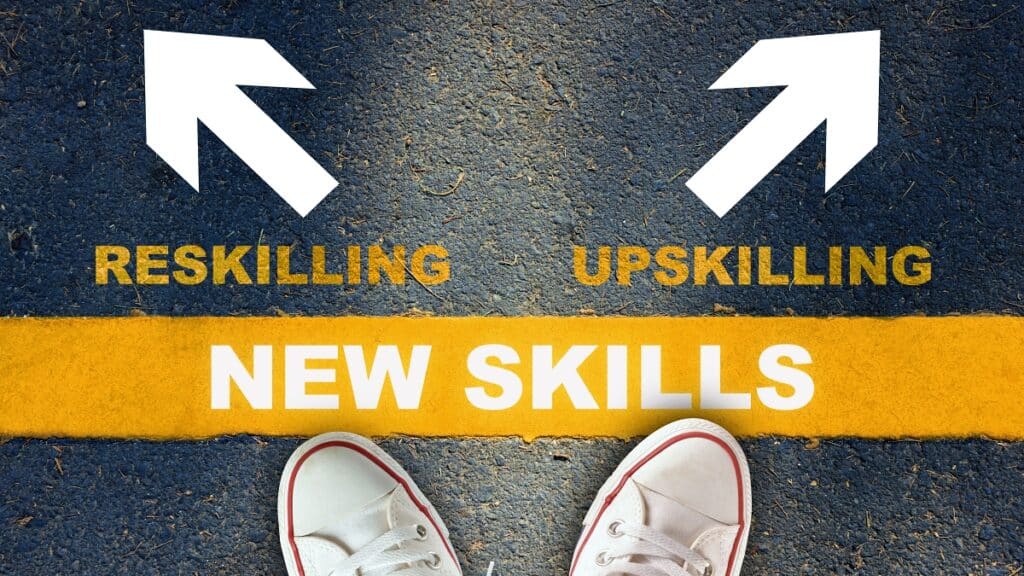Organizations: Your Talent Strategy Must Include Upskilling and Reskilling
Estimated reading time: 4 minutes
(Editor’s Note: Today’s article is brought to you by our friends at Criteria, a leading provider of pre-employment testing services. To learn more about how pre-employment testing can benefit your talent acquisition strategy, check out Criteria’s “Definitive Guide to Pre-Employment Testing”. I’ve found it to be a comprehensive guide that I keep handy all the time. Enjoy!)
A couple of months ago, I published an article about “How to Develop a Workforce and Staffing Plan”. When organizations start that activity, they often realize that they have some skills gaps they need to address. This shouldn’t be a surprise. It’s been difficult to plan over the past couple of years. Organizations might have had plans to implement training programs and it just didn’t happen. But now it’s time to address those plans.
Two of the most common ways to bridge skills gaps are reskilling and upskilling.
Upskilling is giving employees new skills for the job they have today. An example of upskilling would be like manager onboarding. A new manager has the skills for the role but there are additional things they need to know such as budgeting and scheduling, which aren’t typically learned in management development programs.
Reskilling is giving employees new skills for the job they will have in the future. A great case study example of reskilling comes from AT&T. As the organization transitioned from being the “telephone company” to a “digital communications company”, they needed to give employees new skills to grow with the organization. Examples of reskilling would be training in-store customer service representatives to work as remote agents. They’re still doing customer service but they’re doing it a different way. Or a delivery driver who is trained to deliver packages via drone. They’re still delivering packages but the way they do it is different.
Upskilling and reskilling are so important in today’s business environment. We’re already seeing organizations change the way they do things as we emerge from the pandemic. They’re finding new – and better – ways to get things done, service customers, and make profits. But this means that organizations need to give employees the skills to support this new way of doing business.
Naturally, organizations that recognize the need for upskilling and reskilling programs will want to create successful ones. This isn’t a one and done activity. Here are four things to consider as you’re building an upskilling or reskilling program:
Include continuous learning in the organizational culture. The process of learning new skills becomes successful when it’s viewed as a logical normal activity, not a chore mandated by the management team or human resources department. The good news is there are so many different forms of learning – especially in the areas of social media, eLearning, microlearning, etc. – that when we talk about continuous learning it doesn’t always mean traditional classroom learning.
Allocate resources for learning. Learning costs money. It doesn’t have to costs unreasonable amounts of money, but it’s not free. Even programs with free registration costs like a MOOC (massive open online course) require employees to have time away from their daily responsibilities for the purpose of learning. So, companies need to find ways to include learning in their financial and time budgets.
Assess where current employees are and where they need help. Organizations can use a classic gap analysis to determine where they need to target their efforts. Two things can help with this. First, technology systems can tell you the skills that employees currently have. Second, assessments can identify an employee’s level of trainability and competence. Together, these two pieces of information can help the organization begin the process.
Meet with employees to set reskilling or upskilling goals. Managers should meet with employees to discuss where employees are right now from a performance perspective and where they would like their career to be in the future. Employees need to buy-into their skills development plan. Any agreed upon upskilling or reskilling goals can be documented in a format like SMART for monitoring.
Organizations and individuals that want to be ready for the future must think about the skills gap and skills development. As the business world changes, all of us will have to learn new things. And that’s okay. In fact, it’s great. But we need to have a plan in place to make the learning happen.
While reskilling and upskilling are two common activities that organizations need to do to prepare for the future, there are others. I hope you can join me and the Criteria team for a webinar on “Recruitment Strategy: 5 Ways to Future-Proof Your Organization”. It will take place on Thursday, December 2, 2021 at 10a Pacific/1p Eastern. And if you’re already booked that day, sign up to get the recording. It’s going to be a great conversation.
17